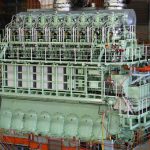Marine diesel engines are engines used to turn the main propellers on marine ships. These engines are made up of several different components, with each component having a specific function to make the engine work as a whole.
There are 11 main components that make up the engine and they are as follows:
- Bedplate: The foundation block for the two-stroke engine, it is built to withstand the constant force from the engine, but is also flexible enough to handle constant fluctuation.
- Crankshaft: It is the main component behind transmitting power to the propeller shaft
- Camshaft: Controls and operates the main three valves (Inlet, Exhaust and Fuel Injector) within the engine— each valve produces at different speeds
- Frame Box: The frame that essentially supports the bed plate
- Piston: Used to convert the force of expanding gases into mechanical energy during the process of combustion
- Piston Rings: Seal the piston therefore, sealing the combustion chamber preventing gas from leaking into the piston and surrounding areas
- Liner: Provides a durable and heat resistant combustion chamber, preventing combustion products from escaping into the engine itself
- Connecting Rod: Takes power from the piston and transfers it to the crankshaft
- Cylinder head: Supports the valves (Inlet, Exhaust and Fuel Injector) necessary for operation
- Inlet and exhaust valves: Inject fresh air into the combustion chamber and eject byproduct out of the chamber
- Turbocharger: This component increases the overall power and efficiency of the engine
Each component plays an important role in powering and running a marine diesel engine. But the engine can’t run unless all components are in place and are in working condition.



Comments are closed